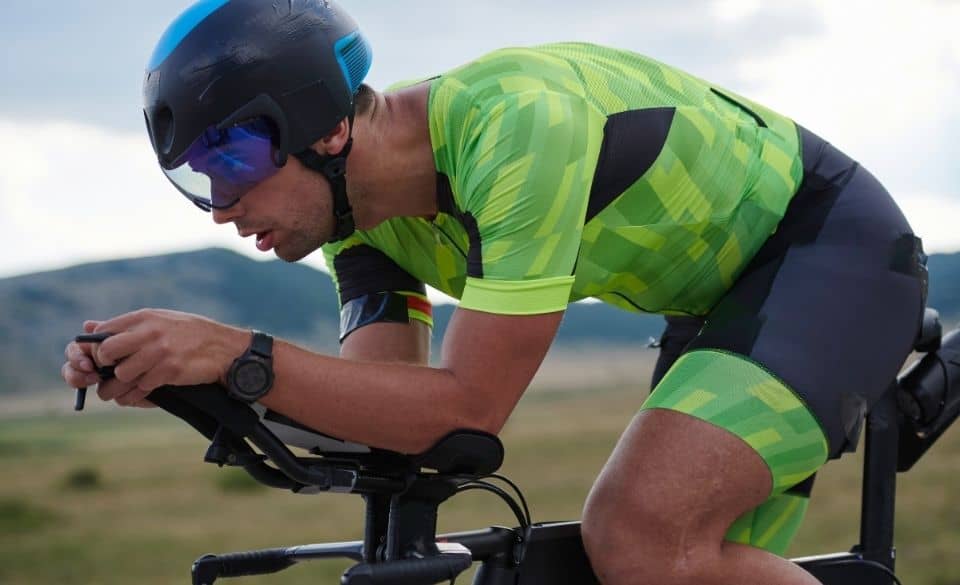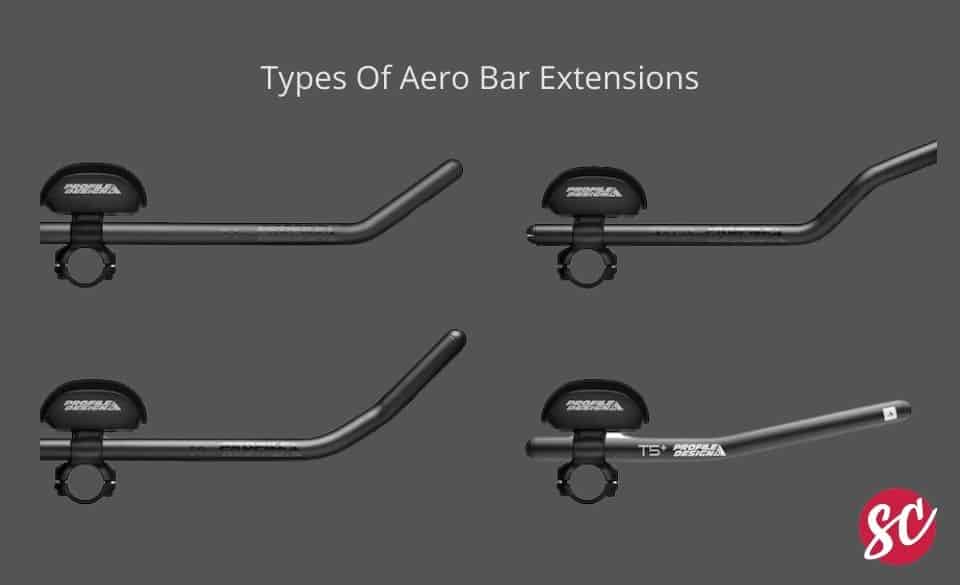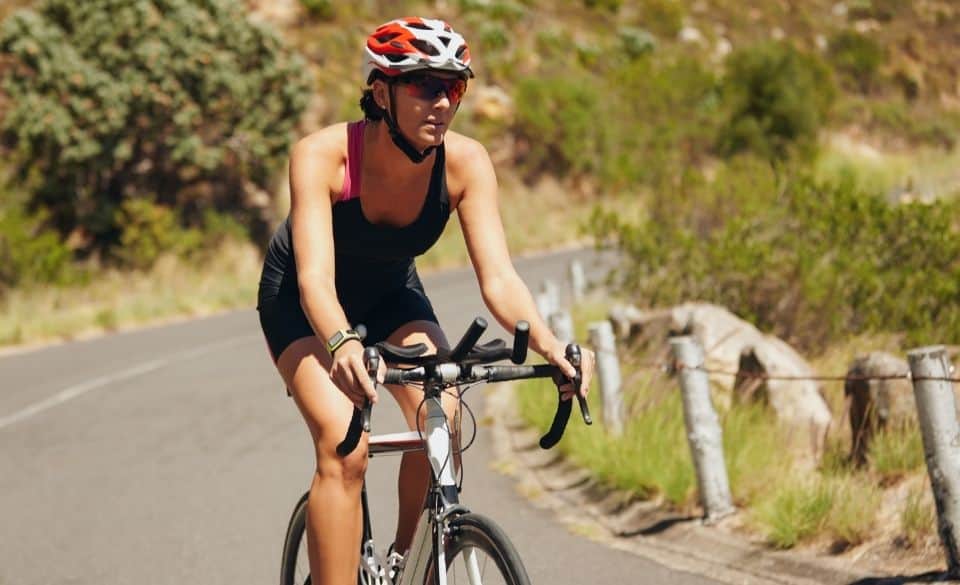
Triathlon Aero Bars – Are Clip-On Aero Bars Worth It? UPDATED 2021
Page Contents
Whether your new to triathlon or had a few races under your belt, aerobars can improve your aerodynamics and speed up your time. Knowing what models are available and the affect they have on your aero position is important. In this article we look at the benefits and types of triathlon aerobars you can buy.
Triathlon Aero Bars – A Complete Guide
Triathlon aero bars are composed of two sections: the first section is the actual extensions. Most manufacturers produce 3-4 different shapes, from s-bend through to the J-bend style. Choosing the shape of the bend should be chosen by the hand position you want and the forearm position/angle needed.
The position of the extensions can usually be rotated inwards and outwards. While the length of the extensions relative to the arm pads can be increased or decreased on 99% of aero bars. This helps to accommodate multiple arm lengths of triathletes and the position of the hands.
The second section is the armrests, these provide comfort and support for the elbows and arms, helping you to maintain a more comfortable position. The padding is usually made of foam for superior comfort and can vary in width and length. Some armrests though can be adjusted to create a more praying mantis style position. This is done by changing the angle of the armrests and helping to close up the frontal area from the wind.
Because manufacturers produce a wide range of triathlon aero bars, you can find models made from alloy through to carbon fiber. Knowing which model to go for depends on the triathlon event you are focusing on.
If you are racing an Olympic distance triathlon where drafting is not permitted, you will need to go for short aero bars. Rules of the ITU mean that you are not allowed the aero bars to exceed past your brake levers.
Non-drafting events though means you can use longer extensions. This can help to position you more aerodynamically by stretching out the body, because there is no restriction on the length.

Are Clip-On Aero Bars Worth It?
There are numerous benefits to using clip-on aero bars and if you are a triathlete, clip-on aero bars are definitely worth it. The position you adopt while using the bars can represent some of the best savings per dollar spent.
Because of the aerodynamic advantage, energy saving is another major benefit. By reducing the frontal drag, your body can reduce the surface exposed to the air. This allows you to save energy by lowering your power needed to ride at the same speed without aero bars.
Clip-on bars are worth installing on your bike if you are racing anything longer than a sprint distance triathlon. Racing over Olympic distance with them can save you 2 minutes or more over the 40 km distance. In longer events they can help drop your time considerably while allowing a more comfortable position on the bike.
Depending on your budget, clip-on bars should be brought based on what arm position you want, rather than the material it’s made from. Since weight is not a factor in most triathlon races, you don’t need to purchase a carbon fiber model. But doing so can help decrease the vibration through the arms, as carbon tends to absorb road vibration much better than alloy.

Do Tri Bar Make A Difference?
Tri bars can make a significant difference in your speed and can help to lower energy consumption at the same power output. Since TRI bars help reduce wind resistance, the power needed is much less than having no TRI bars.
As well improving you speed at the same power output, using TRI bars also effect the alignment of your lower limbs. The change of triathlon bike position will help the body to produce more power to the pedals. So, to get the maximum benefit from TRI bars they need to be fitted correctly.
By making small adjustments over time you can optimize your position to be faster. But make sure you don’t position them past the point of efficiency. Lower and extend the position of the bars once you are comfortable. Then tweak the position until you are in the most aerodynamic position that can produce the highest power output.
Riding at a speed below 12 mph (ca. 19 km/h) most of the aero benefits are gone. So if you’re a slower rider, look to improve your cycling fitness first before investing in a pair of clip-on bars.
Benefits of Aerobars
Your aerodynamic position on the bike is just as important as the power you can produce. The benefits of aerobars is fundamental to success in triathlon and especially if you are at the elite level.
Not all the power you produce goes to the pedals though, some of it is needed to overcome drag force. Drag force is know as the sum of the aerodynamic drag coefficient. This involves the surface area of the rider and the velocity of the rider relative to the air.
Fd = Cd x A x V2
Fd = drag force
Cd = the coefficient of aerodynamic drag
A = airflow (the rider)
V = The velocity relative to the air around the triathlete or cyclist
So in summary, the larger surface area you have on a bike or the faster you go, the greater the drag force. Because of this, the drag accounts for 90% of the resistance triathletes encounters on a bike.
While this may seem difficult to understand, there are other benefits to aerobars, such as the speed increase. Since we already talked about drag force, using aero bars can increase speed by reducing the Cda. In some cases depending on the rider and the bike, you can see an improvement of up to 15% from your base Cda. This means an improvement of 3-5% in speed or just over 2 km/hr as an example.
Since your hands are 90% located on the extensions you have access to the gears without changing your body position. This ends up making you much more efficient at saving energy and staying aerodynamic.
If you forget about all the aerodynamic benefits and your a long course triathlete, they offer a perfect platform for your hydration needs. Most aero bars allow you to mount a hydration bottle between the bars which can provide close to reach nutrition needs during the bike.
Are Aerobars Allowed In Triathlons?
Aerobars are allowed in triathlons but can sometimes be limited in length. This is usually governed by the International Triathlon Union (ITU). Events such as sprint or Olympic distances have set rules on the length of the aerobars for elite triathletes.
In ITU governed events only tradition drop handlebars are allowed and clip-on bars can’t exceed past the brake levers. Another important note is that gear levers are not allowed to be placed on the end of the extensions. For draft-illegal races, aerobars are allowed but must not extend past the leading edge of the front wheel.
For other events not governed by the ITU may have different regulations and it’s worth checking up before you hit the start line.



